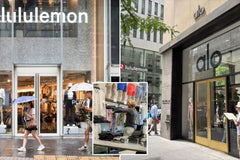
Levi Strauss Reports Strong Growth Amid Strategic Shift to Direct-to-Consumer Model
Table of Contents
- Key Highlights:
- Introduction
- Embracing Direct-to-Consumer Sales
- Financial Performance Highlights
- Building a Denim Lifestyle Brand
- Navigating Tariffs and Market Challenges
- The Future of Levi Strauss
- FAQ
Key Highlights:
- Levi Strauss has reported a 5% increase in net revenues to $2.97 billion in the first half of 2024, with net income reaching $220 million.
- The company successfully generated 50% of its sales through direct-to-consumer (D2C) channels, marking its 13th consecutive quarter of growth in this area.
- Full-year revenue growth expectations have been raised from a forecast of a decline to an increase of 1% to 2%, highlighting the effectiveness of its strategic focus.
Introduction
Levi Strauss & Co. is navigating its way to a brighter future, fueled by a strategic pivot towards becoming a leading denim lifestyle brand. The iconic apparel company recently released its half-year financial update, revealing strong performance metrics that underscore its successful transition. As the company embraces direct-to-consumer (D2C) sales channels, Levi Strauss is not only enhancing its market presence but also redefining its brand identity. The latest data illustrates that the company's sales strategy is resonating well with consumers, reflecting a growing demand for its products amid a competitive retail landscape.
Embracing Direct-to-Consumer Sales
The shift towards direct-to-consumer sales marks a significant evolution in Levi Strauss's business strategy. Currently, the D2C model accounts for 50% of the company's total sales, a clear indication of the brand's commitment to fostering direct relationships with its customers. During the second quarter of 2024, Levi Strauss reported a 10% increase in D2C net revenues, with Europe showing a particularly robust growth of 9%. This momentum is complemented by a 13% rise in ecommerce sales, which further solidifies the effectiveness of its online retail strategy.
The D2C approach allows Levi Strauss to control its branding and customer experience more effectively, enabling the company to engage directly with consumers and adapt to their preferences. Michelle Gass, the company’s president and CEO, emphasized the broad-based strength of the business during this transition. She noted that the second quarter results reflect a clear trajectory of growth, indicating that the strategic agenda to evolve into a denim lifestyle brand is gaining traction.
The focus on D2C aligns with broader retail trends, where brands are increasingly prioritizing direct engagement with consumers. This model not only minimizes reliance on third-party retailers but also enhances profit margins, as companies can eliminate intermediaries in the sales process. For Levi Strauss, this shift is not just about sales; it represents a fundamental change in how the brand connects with its audience.
Financial Performance Highlights
Levi Strauss's financial performance in the first half of 2024 showcases the effectiveness of its strategic initiatives. The company reported a net income of $220 million against a backdrop of net revenues of $2.97 billion, reflecting a 5% year-on-year increase. The second quarter alone saw a net income of $80 million on revenues of $1.4 billion, marking a 6% growth compared to the previous year. Particularly noteworthy is the 14% revenue growth in Europe, which is indicative of the brand's strong international presence and appeal.
The financial outlook for the remainder of the year is optimistic, with Levi Strauss adjusting its full-year expectations. The company now anticipates net revenue growth between 1% and 2%, a notable rise from prior projections that anticipated a decline. This adjustment is underpinned by an expected like-for-like revenue growth of 4.5% to 5.5%, an increase from earlier predictions of 3.5% to 4.5%. Such revisions suggest that Levi Strauss is not only weathering external challenges, such as tariff impacts on imports, but is also capitalizing on its strategic focus.
Harmit Singh, the chief financial and growth officer, attributed this positive inflection in financial performance to the company’s unwavering focus on the core Levi's brand and a DTC-first approach. He stated that the strong performance in the first half of the year has emboldened the company to raise its expectations, reflecting confidence in the ongoing strategic execution.
Building a Denim Lifestyle Brand
Levi Strauss's ambition to transform into a denim lifestyle brand is central to its growth strategy. This transformation involves expanding the product range beyond traditional denim jeans to include a broader array of clothing and accessories that resonate with contemporary fashion trends. The recent collaboration with the Oasis reunion tour exemplifies this approach, leveraging cultural moments to enhance brand relevance and attract a diverse consumer base.
By positioning itself as a lifestyle brand, Levi Strauss aims to tap into the growing consumer interest in brands that embody a particular way of life. This strategy not only diversifies its product offerings but also enhances customer loyalty, as consumers increasingly seek brands that reflect their values and lifestyle choices. The integration of lifestyle elements into the brand narrative allows for greater storytelling and engagement with customers, ultimately fostering a deeper emotional connection.
The evolution towards a lifestyle brand also necessitates a keen understanding of market trends and consumer preferences. Levi Strauss is well-equipped to navigate this landscape, given its rich heritage and longstanding reputation in the denim industry. By combining its historical roots with modern sensibilities, the company is poised to capture the attention of both longstanding fans and new consumers alike.
Navigating Tariffs and Market Challenges
Despite the positive financial trajectory, Levi Strauss faces external pressures, particularly concerning tariffs on imports from China and other regions. The company assumes that U.S. tariffs on imports from China will remain at 30%, while tariffs from other countries will hold at 10%. Such economic factors could potentially impact pricing strategies and profit margins in the future.
However, Levi Strauss has shown resilience in adapting to these challenges. The company's strategic focus on D2C sales mitigates some of the risks associated with rising costs, as it allows for more direct pricing control and customer engagement. By fostering strong relationships with consumers, Levi Strauss can better navigate market fluctuations and maintain brand loyalty.
Moreover, the company's proactive approach to supply chain management and cost control will play a crucial role in sustaining profitability amidst these challenges. By optimizing operational efficiencies and exploring alternative sourcing options, Levi Strauss can continue to deliver value to its customers while safeguarding its financial health.
The Future of Levi Strauss
As Levi Strauss forges ahead, its commitment to innovation and adaptability will be pivotal in shaping its future trajectory. The company’s efforts to enhance its digital capabilities and streamline customer experiences are essential components of its growth strategy. Investing in technology and data analytics will enable Levi Strauss to better understand consumer behaviors and tailor offerings accordingly.
Furthermore, global sustainability initiatives are increasingly becoming a priority for consumers, and Levi Strauss is well-positioned to lead in this area. The company has historically been a pioneer in sustainable practices within the denim industry, and continuing to innovate in this space will resonate strongly with environmentally conscious consumers.
The potential for international expansion remains significant, especially in emerging markets where denim remains a staple fashion choice. By leveraging its brand legacy and adapting marketing strategies to local preferences, Levi Strauss can capture new growth opportunities and strengthen its global footprint.
FAQ
What is the current financial status of Levi Strauss?
Levi Strauss reported net revenues of $2.97 billion in the first half of 2024, with a net income of $220 million, reflecting a 5% increase in revenues year-on-year.
How much of Levi Strauss's sales come from direct-to-consumer channels?
Currently, 50% of Levi Strauss's sales are generated through direct-to-consumer channels, including its own retail stores and ecommerce platforms.
What are the future growth expectations for Levi Strauss?
The company has raised its full-year revenue growth expectations to between 1% and 2%, along with a like-for-like revenue growth forecast of 4.5% to 5.5%.
How is Levi Strauss addressing market challenges like tariffs?
Levi Strauss is navigating tariff challenges by focusing on its D2C strategy, which allows for better pricing control and enhanced customer relationships, thus mitigating some of the risks associated with rising costs.
What is Levi Strauss's strategy for becoming a lifestyle brand?
Levi Strauss aims to transform into a denim lifestyle brand by expanding its product offerings beyond traditional denim to include a wider range of clothing and accessories that resonate with contemporary consumer trends.
E-ticaretinizi haftalık içgörülerimiz ve güncellemelerimizle güçlendirin!
Ticaret dünyasında neler olup bittiğiyle uyumlu kalın
E-posta Adresi
Sizin İçin Seçilmiş

11 July 2025 / Blog
Lululemon Faces Stiff Competition and Changing Consumer Sentiment: What’s Next for the Yoga Retail Giant?
Daha Fazla Oku
11 July 2025 / Blog
Empowering Small Businesses: The Essential Role of Payment Gateways in Modern Commerce
Daha Fazla Oku
11 July 2025 / Blog


